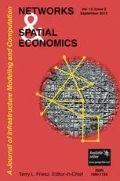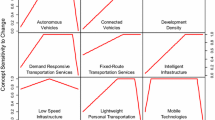Abstract
The en-route driver behavior problem under information provision is characterized by subjective and linguistic variables, in addition to situational factors. Fuzzy modeling provides a robust mechanism to capture subjectivity and/or the linguistic nature of the causal variables. This motivates the development of a hybrid en-route route choice model that combines quantitative and fuzzy variables to more robustly predict driver routing decisions under information provision. Simulation experiments are conducted to analyze the ability of the hybrid model to capture en-route driver behavior effects in the within-day and day-to-day contexts.
Similar content being viewed by others
References
Abdel-Aty, M.A., R. Kitamura, and P.P. Jovanis. (1997). “Using Stated Preference Data for Studying the Effect of Advanced Traffic Information on Drivers’ Route Choice.” Transportation Research 5C, 39–50.
Ben-Akiva, M. and S.R. Lerman. (1985). Discrete Choice Analysis: Theory and Application to Travel Demand. Cambridge, MA: MIT Press.
Chen, T., H. Chang, and G. Tzeng. (2001). “Using a Weight-Assessing Model to Identify Route Choice Criteria and Information Effects.” Transportation Research 35A, 197–224.
Dubois, D. and H. Prade. (1988). “Default Reasoning and Possibility Theory.” Artificial Intelligence 35, 243–257.
Fujii, S. and R. Kitamura. (2000). “Anticipated Travel Time, Information Acquisition, and Actual Experience.” Transportation Research Record 1725, TRB. Washington, D.C: National Research Council, pp. 79–85.
Jha, M., S. Madanat, and S. Peeta. (1998). “Perception Updating and Day-to-Day Travel Choice Dynamics in Traffic Networks with Information Provision.” Transportation Research 6C, 189–212.
Khattak, A.J. and A. de Palma. (1997). “The Impact of Adverse Weather Conditions on the Propensity to Change Travel Decisions: A Survey of Brussels Commuters.” Transportation Research 31A, 181–203.
Lotan, T. (1997). “Effects of Familiarity on Route Choice Behavior in the Presence of Information.” Transportation Research 5C, 225–243.
Lotan, T. (1998). “Modeling Discrete Choice Behavior Based on Explicit Information Integration and its Application to the Route Choice Problem.” IEEE Transactions on Systems, Man, and Cybernetics–-Part A: Systems and Humans 28(1), 100–114.
Lotan, T. and H.N. Koutsopoulos. (1999). “Modeling Default Behavior in the Presence of Information and its Application to the Route Choice Problem.” International Journal of Intelligent Systems 14, 501–533.
Mahmassani, H.S. and Y. Liu. (1999). “Dynamics of Commuting Decision Behavior Under Advanced Traveller Information Systems.” Transportation Research 7C, 91–107.
Nakayama, S. and R. Kitamura. (2000). “Route Choice Model with Inductive Learning.” Transportation Research Record 1725. Washington, D.C.: TRB, National Research Council, pp. 63–70.
Pang, G.K.H., K. Takahashi, T. Yokota, and H. Takenaga. (1999). “Adaptive Route Selection for Dynamic Route Guidance System Based on Fuzzy-Neural Approaches.” IEEE Transactions on Vehicular Technology 48(6), 2028–2040.
Peeta, S. and S. Gedela. (2001). “Real-Time Variable Message Sign-Based Route Guidance Consistent with Driver Behavior.” Transportation Research Record 1752. Washington, D.C.: TRB, National Research Council, pp. 117–125.
Peeta, S., J.L. Ramos, and R. Pasupathy. (2000). “Content of Variable Message Signs and On-line Driver Behavior.” Transportation Research Record 1725. Washington, D.C.: TRB, National Research Council, pp. 102–108.
Peeta, S. and J.W. Yu. (2002a). “A Data-Consistent Fuzzy Approach for On-line Driver Behavior Under Information Provision.” Transportation Research Record 1803. Washington D.C.: TRB, National Research Council, pp. 76–86.
Peeta, S. and J.W. Yu. (2002b). “On Behavior-Based Consistency-Seeking Models as Alternatives to Dynamic Traffic Assignment Models for Real-Time Deployment.” Submitted to Transportation Research Part C.
Peeta, S. and J.W. Yu. (2004a). “Experimental Analysis of a Hybrid Route Choice Model to Capture Dynamic Behavioral Phenomena Under Advanced Information Systems.” Submitted to Transportation Research Part B.
Peeta, S. and J.W. Yu. (2004b). “Adaptability of a Hybrid Route Choice Model to Incorporating Driver Behavior Dynamics Under Information Provision.” IEEE Transactions on Systems, Man, and Cybernetics–-Part A: Systems and Humans 34(2), 243–256.
Srinivasan, K.K. and H.S. Mahmassani. (2000). “Modeling Inertia and Compliance Mechanisms in Route Choice Behavior Under Real-Time Information.” Transportation Research Record 1725. Washington, D.C.: TRB, National Research Council, pp. 45–53.
Tsoukalas, L.H. and R.E. Uhrig. (1997). Fuzzy and Neural Approaches in Engineering. New York: John Wiley and Sons, Inc.
Author information
Authors and Affiliations
Corresponding author
Rights and permissions
About this article
Cite this article
Peeta, S., Yu, J.W. A Hybrid Model for Driver Route Choice Incorporating En-Route Attributes and Real-Time Information Effects. Netw Spat Econ 5, 21–40 (2005). https://doi.org/10.1007/s11067-005-6660-9
Issue Date:
DOI: https://doi.org/10.1007/s11067-005-6660-9




